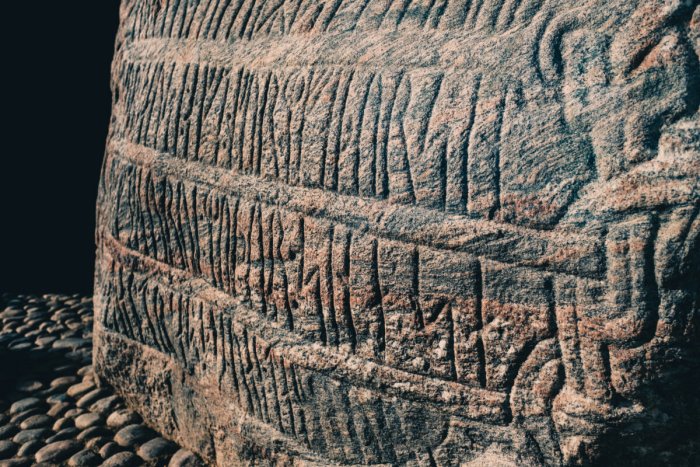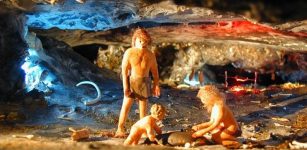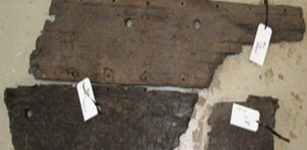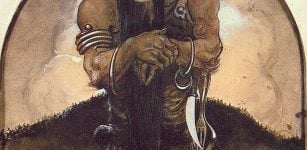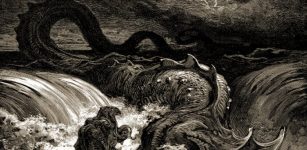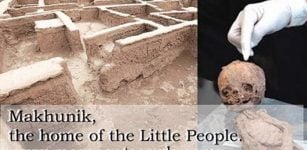3D Scans Of Runestones Reveal The Power Of Viking Queen Thyra
Jan Bartek – MessageToEagle.com – Archaeologists have used 3D scanning to investigate inscriptions carved on two groups of Danish runestones, revealing that four stones were likely made in dedication to a powerful Viking Queen named Thyra.
The study reveals who carved the runes on the iconic Jelling Stone, and discovery shows that Queen Thyra was far more important than was previously assumed.
The two Jelling stones. Credit: National Museum of Denmark
According to the study published in the journal Antiquity, the first group, the Jelling Stones, were raised by Harald Bluetooth, the king who is credited with founding the Danish state, in commemoration of his parents Gorm and Thyra. The second group, the Ravnunge-Tue Stones, also mention a woman called Thyra.
Runemaster Ravnunge-Tue
“To an extent, just as handwriting is individual and can identify the owner of the writing, it turns out that, even though they were carved in stone, runes also reflect the runemaster.
3D scans of runestones enable researchers to gain a close-up view of traces of the carving process. This means they can tell the carving technique of the different rune stones apart. Every experienced stonemason holds his chisel at a certain angle and strikes the hammer with a specific force: this is visible in the angle of the traces of the carving and the distance between them. The motor function developed in such work is individual. Consequently, the researchers can now reveal the name of the runemaster who carved the Jelling Stone.
His name was Ravnunge-Tue: a Viking Age rune carver. Although few people will have heard of him, he is quite well-known in professional circles.
The inscription of the larger Jelling stone. Credit: National Museum of Denmark
We know his name from the Læborg Stone situated 30 kilometres southwest of Jelling. The same carving technique that can be traced in the runes on the Jelling Stone are also evident on the Læborg Stone. The text on the Læborg stone reads: “Ravnunge-Tue carved these runes in memory of Thyra, his queen,” the National Museum of Denmark informs in a press statement.
Lisbeth Imer, a runologist and senior researcher at the National Museum of Denmark, explains that the discovery is interesting in itself, because it links yet another person to the Jelling dynasty. But what makes it particularly interesting is the fact that it also involves another interesting revelation.
Dr. Lisbeth Imer. Credit: National Museum of Denmark
Together with Laila Kitzler Åhfeldt of Riksantikvarieämbetet in Stockholm and Henrik Zedig of Länsstyrelsen in Västergötland, she conducted the research.
“We wanted to see if we could find the same rune carver on some of these stones, so that we could connect the Ravnunge-Tue stones with the Jelling stones,” says Dr. Imer from the National Museum of Denmark.
“If there was a connection, it would be highly likely that all the stones referred to the same woman, Thyra, mother of Harald Bluetooth.”
Læborg Stone. Credit: National Museum of Denmark
To test the validity of this theory, Dr. Imer and a team of investigators from several Scandinavian institutions made 3D models of the runestones and analyzed the shape and carving techniques used to cut the runes and the language used.
The authors compared carved grooves of well-preserved runestones in order to identify the distinctive marks made by different carvers. Similarities between the runes of the Læborg Stone (one of the Ravnunge-Tue Stones) and the Jelling 2 Stone suggest that they were engraved by the same person.
Therefore, the references to Thyra on both groups of stones likely refer to the same person—the Danish Queen and mother of Harald Bluetooth. This indicates that she was a particularly powerful and celebrated individual. It is likely that she held land and authority in her own right, not only through her husband.
“The fact that we now know the name of the rune carver of the Jelling Stone is incredible; but what makes the discovery even more amazing is the fact that we know who Ravnunge-Tue’s boss was. She was Queen Thyra of Jelling – mother of Harald Bluetooth, wife of Gorm the Old,” says Lisbeth Imer.
The two Jelling stones mention Queen Thyra as the mother of Harald Bluetooth, wife of Gorm the Old and ‘Denmark’s salvation’. However, the name Thyra also appears on two other rune stones: the Læborg Stone, which Ravnunge-Tue carved in memory of Thyra; and Bække 1, which bears the inscription, ‘Ravnunge-Tue and Fundin and Gnyple, these three made Thyra’s mound.’
For many years, researchers have been debating whether the Queen Thyra of the Læborg Stone is the same as the Jelling Thyra.
3D scan reveals that queen Thyras runemaster Ravnunge Tue carved the Jelling Stone. Credit: National Museum of Denmark
However, based on the new research, the likelihood of two different Thyras is significantly less, because, according to the researchers who conducted the analyses, Ravnunge-Tue carved both the Læborg Stone and the Jelling Stone. Lisbeth Imer believes that this also highlights just how important Queen Thyra was.
Queen Thyra is mentioned on a total of four rune stones: more than any other person in Viking-Age Denmark. This is particularly noteworthy, since rune stones erected in honor of women are rare. By comparison, Harald Bluetooth and Gorm the Old are each mentioned on just two rune stones, and Gorm the Old is only mentioned in connection with Thyra.
“This means that Queen Thyra was far more important than we previously assumed. She probably came from a nobler, older family than Gorm the Old, whom we usually refer to as the first King of Denmark. This is extremely interesting when it comes to understanding the power structure and the genesis of Denmark as a nation,” says Lisbeth Imer.
All four rune stones that mention Thyra are located in Southern Jutland, implying that her power was based in this area, while Gorm the Old may have come from elsewhere.
See also: More Archaeology News
“It is a wonderful insight. It relates to the ‘birth certificate’ of our country and the founding of early Denmark. Once again, our researchers have proved why we must continue to delve into the history of Denmark. That includes the part we already know, because we are constantly finding new answers that increase our knowledge of the past,” says Rane Willerslev, Director of the National Museum of Denmark.
The Jelling Stone
Featuring in every Danish passport, the Jelling Stone is known as the ‘birth certificate’ of Denmark, in which, 1,000 years ago, Harald Bluetooth boasted that he had united Denmark and Norway, and converted the Danes to Christianity. In 1994, the runestone was the main justification for Jelling’s inclusion on the UNESCO World Heritage List. It was the first site in Denmark to be granted that honor. The stone still stands on its original site. There are copies of the Jelling Stone all over the world: from Tokyo to Los Angeles.
Written by Conny Waters – AncientPages.com Staff Writer


